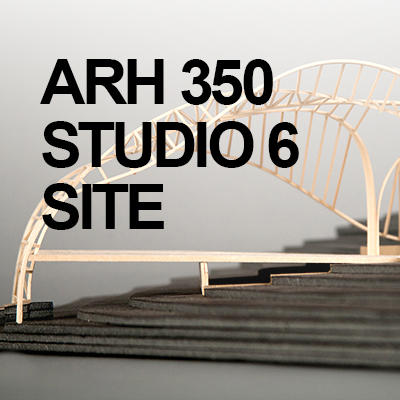
ARH 350 STUDIO 6 SITE CONDITIONS AND BUILDING PERFORMANCE
Design a visitor’s center attuned to its natural habitat and historical context. Physical site environments provide opportunities for design synthesis and responsible energy use. You will incorporate passive design principles in response to climate, orientation, topography, vegetation, views, building materiality, and constructability.
Prerequisites: ARH 240, ARH 315, ARH 390, ARH 430 and either ARH 320 or ARH 330
Software: Rhino, Adobe Creative Cloud, Climate Consultant, Climate Studio, Rendering Engine
Course Learning Outcomes
- Create a site-specific design proposal using an iterative process to respond to Technical Advisor feedback on climate and sustainability
(NAAB SC5 Design Synthesis) - Correlate site climate data with passive heating and cooling strategies such as daylighting, natural ventilation, use of thermal mass
(NAAB SC5 Design Synthesis: Measurable Env. Impact) - Visually document the process of optimizing building orientation and massing using simulation tools for solar analysis
(NAAB SC5 Design Synthesis: Measurable Env. Impact) - Accurately document proposed change to topography that avoids excessive cut-and-fill, minimizes disruptions to the ecology, and protects the watershed
(NAAB SC5 Design Synthesis: Site Conditions) - Compare per-unit embodied carbon of building materials and develop selection criteria for performance and design goals
(NAAB SC5 Design Synthesis: Measurable Env. Impact) - Create wall section detail and model of a building envelope system synthesizing performance and design goals
- Coordinate architectural floor plans with a structural grid to achieve a logical building organization
- Organize efficient floor plans to meet program requirements such as square footage, adjacencies, circulation, public/private space separation
(NAAB SC5 Design Synthesis: User Requirements) - Provide accessible circulation in interior and exterior spaces (NAAB SC5 Design Synthesis: Accessible Design)
- Provide two means of egress in all occupied spaces
(NAAB SC5 Design Synthesis: Regulatory Requirements)
NAAB Criteria
- Student work from this course will meet all or part of NAAB SC.5 Design Synthesis (Ability): How the program ensures that students develop the ability to make design decisions within architectural projects while demonstrating synthesis of user requirements, regulatory requirements, site conditions, and accessible design, and consideration of the measurable environmental impacts of their design decisions
- This course addresses NAAB Shared Values of Design: Architects design better, safer, more equitable, resilient, and sustainable built environments. Design thinking and integrated design solutions are hallmarks of architecture education, the discipline, and the profession
Student Project by: Huilan Hu
